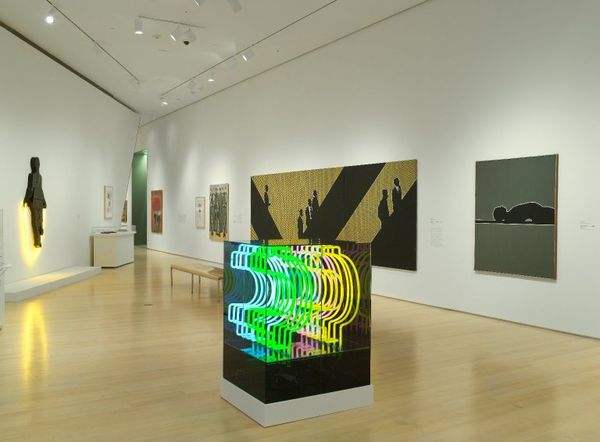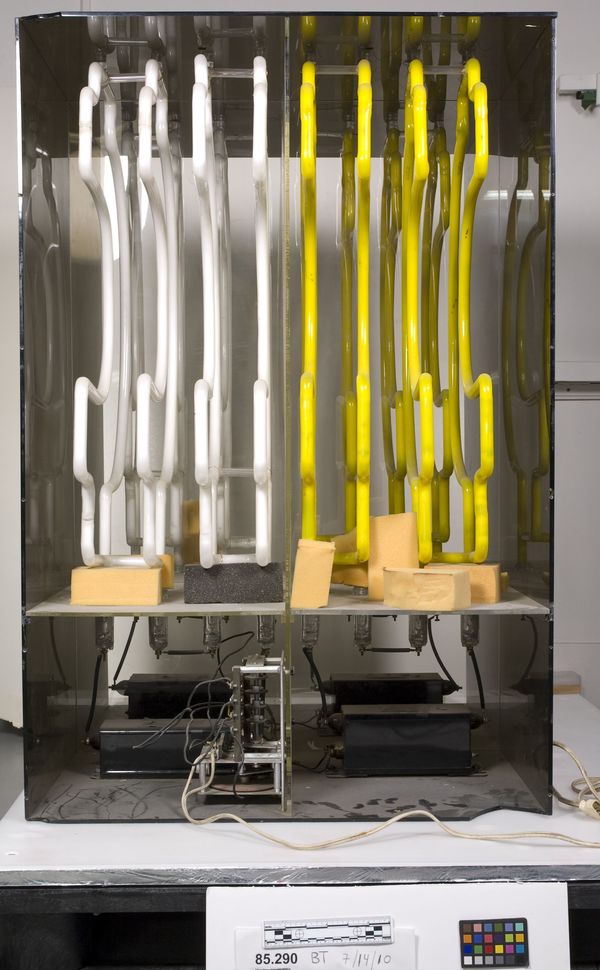Cents Sign Traveling From Broadway to Africa via Guadeloupe
When I first saw Chryssa’s neon sculpture in storage in late 2004, the object was in an unexhibitable state, missing the two end pieces of the Plexiglas box, with scratches and small losses on the existing sides of the box. We also had no idea whether or not the neon lights worked.

Chryssa's Cents Sign Traveling From Broadway to Africa via Guadeloupe on view in Seductive Subversion: Women Pop Artists, 1958–1968, October 15, 2010 through January 9, 2011 (Image: DIG_E2010_Seductive_Subversion_04_PS4.jpg. Brooklyn Museum photograph, 2010)
In January of 2005 we contacted David Ablon at Tecnolux a neon specialist who has worked with many artists who work in neon, including Chryssa herself. It was at that point we determined that the neon was in great working order. The outer box on the other hand was a problem. Before considering undertaking an extensive conservation treatment on a work of art by a living artist, it is necessary to consult the artist on possible treatment plans so that the conserved work will remain true to the artist’s intentions. Chryssa was born in 1933 and luckily for us was alive in 2005. Through a very circuitous route, (a Greek man in my Spanish class), we managed to find her contact information in NYC. We gained permission to have the outer box re-made so that the artwork could be exhibitable.

Photo shows the missing sides of the original box. Chryssa (American, born Greece, 1933). Cents Sign Travelling from Broadway to Africa via Guadeloupe, 1968. Neon tubing and plexiglass, 43 x 35 x 28 1/2 in. (109.2 x 88.9 x 72.4 cm). Brooklyn Museum, Gift of Sidney Singer, 85.290. © artist or artist's estate
When Catherine Morris Curator for the Elizabeth A. Sackler Center for Feminist Art put the Chryssa on the Seductive Subversion: Women Pop Artists, 1958–1968 checklist, the project was a go! Grewe Plastics, Inc. was contracted to remake the neon box. They have worked with conservators from MOMA, and other artists in fabricating and re-fabricating precise plastic elements. The very difficult part in undertaking this conservation treatment was coordinating and communicating the work and the needs of the two specialists—the neon fabricator and the plastics fabricators—to ensure that the neon would fit inside the new box.
I first worked with David to disassemble the neon from the damaged box. A nerve racking process as Chryssa’s three dimensional neon tubes are extremely fragile. David can be heard in this video describing the colors of the neon before we begin the disassembly process. The difficult part for the plastics fabricators is that they had the original box, but had to replicate all of the holes, and transfer the internal shelves with extreme precision so that the neon tubes could be reinstalled inside the new box. Although there was a few moments of nail biting, both specialists were excellent and the end result is a completely transformed, exhibitable work of art.

Lisa Bruno is the head conservator of objects at the Brooklyn Museum, where she has been working since 1993. She has previously worked at the Art Institute of Chicago, and has had internships at The Cleveland Museum of Art, the Detroit Institute of Arts, and in private practice. She has a Masters Degree in Art Conservation from the University of Delaware, Winterthur Museum Art Conservation Department. She is a Professional Associate of the American Institute for Conservation.
